
The Rhinoceros Hornbill in nature.
Hornbills those Magnificent Soft Billed Winged Creatures
Last Updated on by Mitch Rezman
First, we took a look at soft-billed birds which lead to an exploration of the differences between softbills – hardbills – hookbills & waxbills.
Hornbills are softbills like Toucans but don’t get a lot of press or even cereal of their own.
Feathered factoid: Many people lump Toucans into the same category as Hornbills but the reality is they come from different continents.
Toucans reside in Central and South America while Hornbills hark from Africa and Asia.
How many species of Hornbills are there?
Between the images below and the list at the bottom of the page, there appear to be about 5 dozen Hornbill species – give or take.
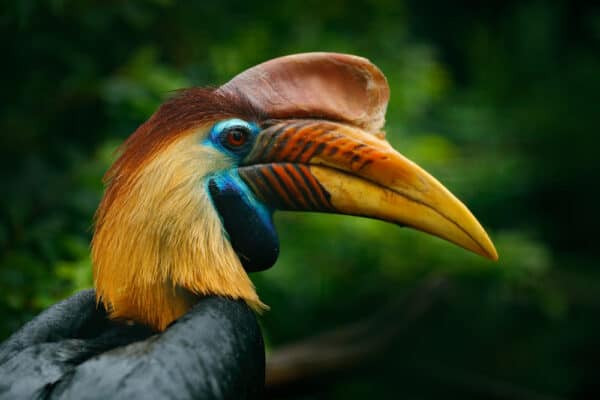
Red-knobbed Hornbill
and yes – some people do keep them as pets.
You’ll need a walk-in aviary if you’re thinking about it and no I don’t know where the heck to get a Hornbill.
btw – some species of Hornbills can make a Blue and Gold Macaw – seem small.
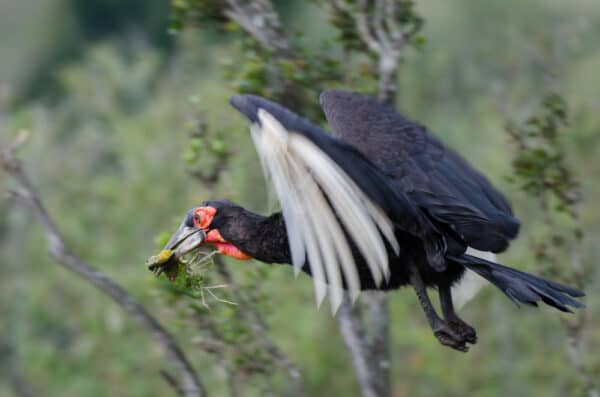
Southern Ground Hornbill
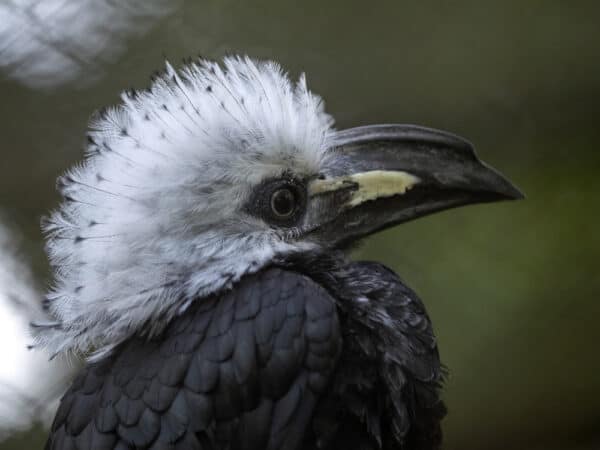
White-crested Hornbill
Feathered factoid: Hornbills are omnivores.
In other words, they will eat just about anything from fruit to insects and small animals.
If you ever French kiss a Hornbill you will probably be disappointed (as most French kisses end up – or so I’m told).
See they can’t swallow food if they catch it at the tip of their beak because their tongues are too short so they can’t move the food around in their mouth.
That’s why you see them in the videos below toss the food to the back of their throat with a jerking motion of their head.
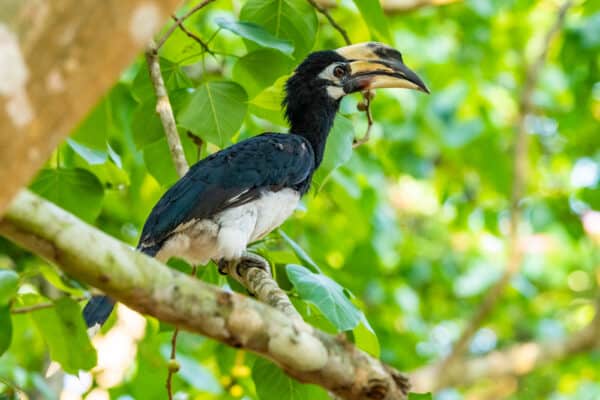
Oriental Pied Hornbill
Feathered factoid: Asian Hornbills although omnivores like most other Hornbills prefer fruit and small animals.
Figs are their favorite fruit.
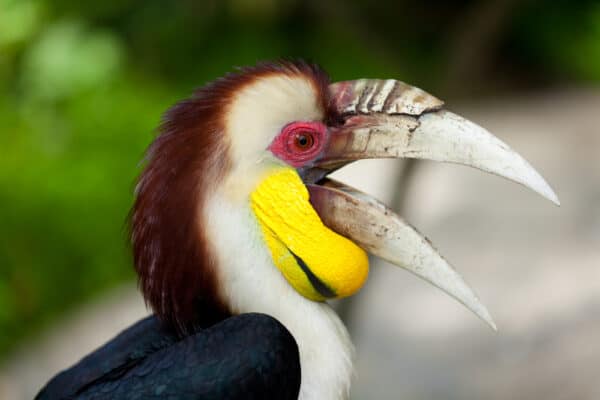
Wreathed Hornbill
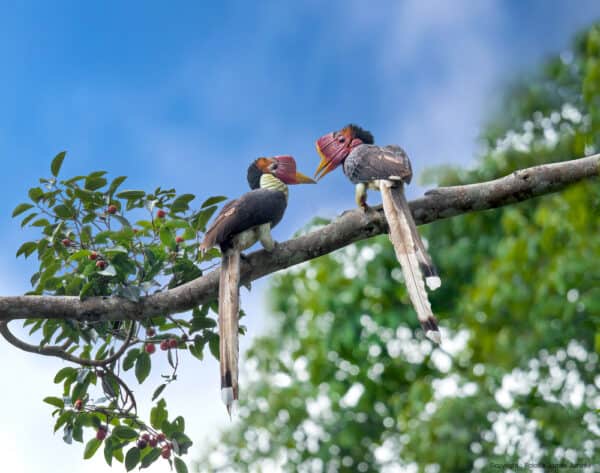
(Uniquely long tailed) Helmeted Hornbill

Rufous Hornbill
Feathered factoid: Hornbills are prolific baby snatchers, especially during the breeding season.
They wine and dine their potential and current spouses with lizards, geckos, earthworms, frogs, caterpillars, beetles, butterflies, and grasshoppers all proudly absconded from nearby family homes.
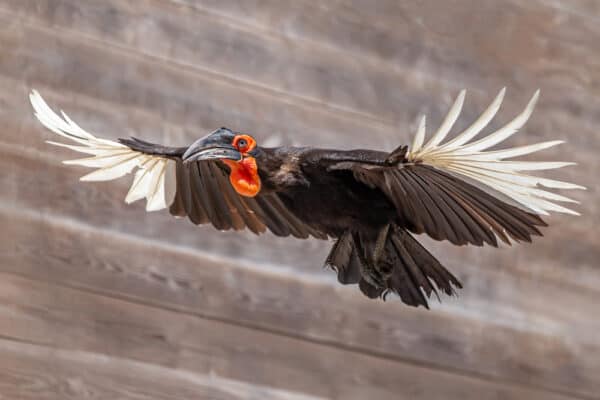
Southern Ground Hornbill
Feathered Factoid: Hornbills, Ostriches & Secretary birds are the only birds that have eyelashes!
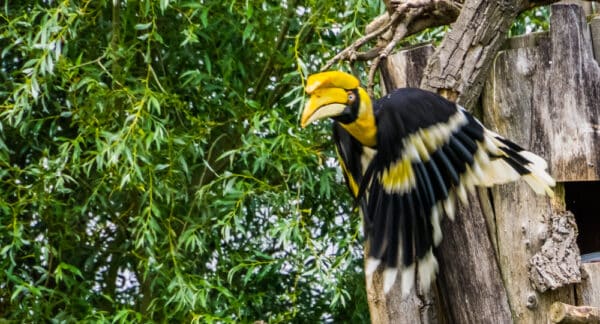
Great Hornbill
Feathered factoid: Although Great Hornbills “settle” for fruits especially those yummy figs, they are active hunters always looking for snakes lizards, bird nestlings including their eggs, beetles and most any other insect they can trap with their enormous beak.
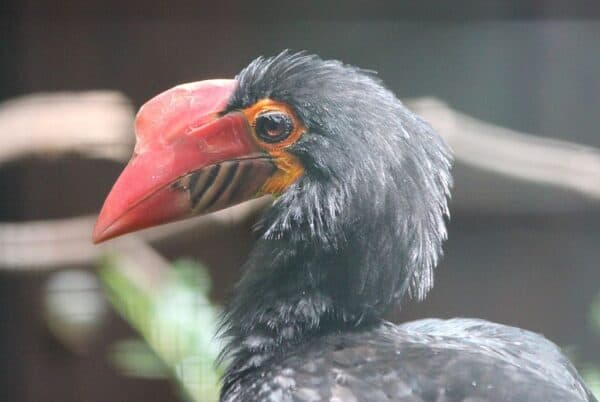
Mindanoa Hornbill
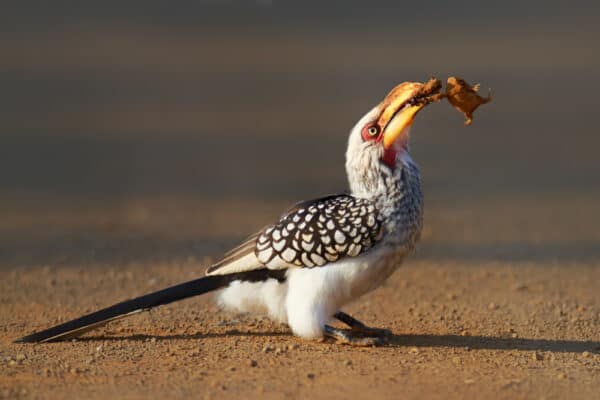
Yellow billed Hornbill
Feathered factoid: Hornbills are actually related more closely to Kingfishers and Toucans which are not so distant cousins to woodpeckers.

Trumpeter Hornbill

Abyssinian ground Hornbill
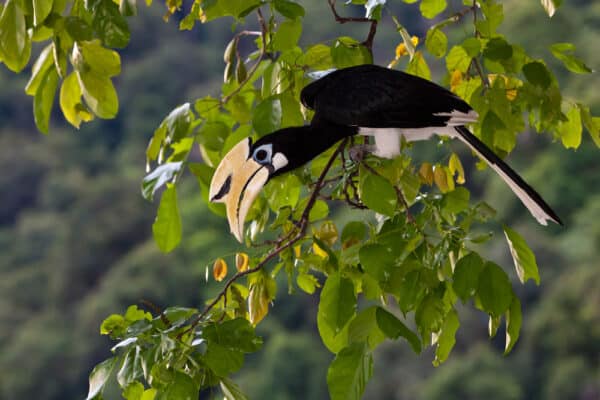
Palawan Hornbill
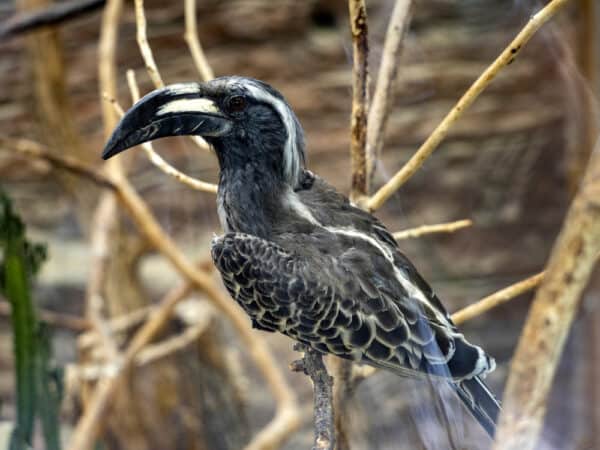
African grey Hornbill
Warning – micro science lesson ahead: There’s a phenomenon in nature called “convergent evolution” which is used to explain why Toucans and Hornbills have so many similarities.
The theory is that two entirely different species from two entirely different geographic areas can adapt in a similar fashion in order to survive in their particular ecological situation.
![1024px-Rhyticeros_plicatus_-Lincoln_Park_Zoo-8a-3c Blyth's hornbill (Rhyticeros plicatus), also known as the Papuan hornbill, is a large hornbill inhabiting the forest canopy in Wallacea and Melanesia. Its local name in Tok Pisin is kokomo.[3]](https://windycityparrot.com/wp-content/uploads/1024px-Rhyticeros_plicatus_-Lincoln_Park_Zoo-8a-3c-600x600.jpg)
Papuna Hornbill (the Ed Sullivan of Hornbills)
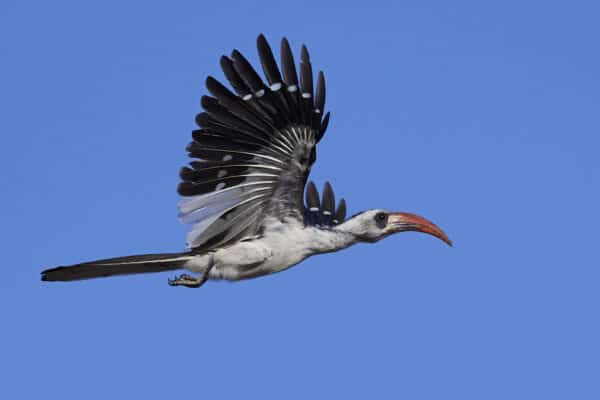
Western Red-Billed Hornbill
![rinoceros-hornbill-flight-blog The rhinoceros hornbill (Buceros rhinoceros) is a large species of forest hornbill (Bucerotidae). In captivity it can live for up to 35 years. It is found in lowland and montane, tropical and subtropical climates and in mountain rain forests up to 1,400 metres in Borneo, Sumatra, Java, the Malay Peninsula, Singapore, and southern Thailand.[1]](https://windycityparrot.com/wp-content/uploads/rinoceros-hornbill-flight-blog-600x375.jpg)
(male) Rhinoceros Hornbill
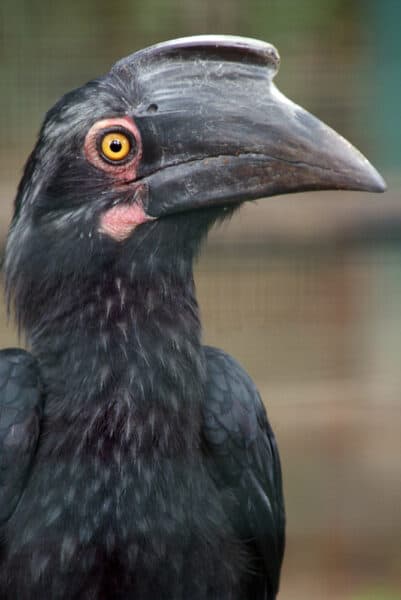
Female Black Hornbill
We’ll continue to add images as we find them, until then be on the look out for the following species of hornbills:
African grey hornbill Tockus nasutus
African pied hornbill Tockus fasciatus
Austen’s brown hornbill, Anorrhinus austeni
Black dwarf hornbill Tockus hartlaubi
Black hornbill Anthracoceros malayanus
Black-and-white-casqued hornbill
Black-casqued wattled hornbill Ceratogymna atrata
Bradfield’s hornbill Tockus bradfieldi
Bushy-crested hornbill Anorrhinus galeritus
Crowned hornbill Tockus alboterminatus
Damara red-billed hornbill Tockus damarensis
Eastern yellow-billed hornbill Tockus flavirostris
Great hornbill Buceros bicornis
Helmeted hornbill Rhinoplax vigil
Hemprich’s hornbill Tockus hemprichii
Indian grey hornbill
Indian grey hornbill Ocyceros biostris
Jackson’s hornbill Tockus jacksoni
Knobbed hornbill Aceros cassidix
Luzon hornbill Penelopides manillae
Malabar grey hornbill Ocyceros griseus
Malabar pied hornbill Anthracoceros coronatus
Mindanao hornbill Penelopides affinis
Mindoro hornbill Penelopides mindorensis
Monteiro’s hornbill Tockus monteiri
Narcondam hornbill Rhyticeros narcondami
Northern red-billed hornbill Tockus erythrorhynchus
Oriental pied hornbill Anthracoceros albirostris
Palawan hornbill Antracoceros marchei
Palawan hornbills, have a pied plumage
Pale-billed hornbill, Tockus pallidirostris
Papuan hornbill Rhyticeros plicatus
Plain-pouched hornbill Rhyticeros subruficollis
Red-billed dwarf hornbill Tockus camurus
Red-billed hornbill
Red-billed hornbill group
Rhinoceros hornbill Buceros rhinoceros
Rufous hornbill Buceros hydrocorax
Rufous-headed hornbill Aceros waldeni
Rufous-necked hornbill Aceros nipalensis
Samar hornbill Penelopides samarensis
Southern ground hornbill (bluish throat indicates female)
Southern red-billed hornbill Tockus rufirostris
Southern yellow-billed hornbill Tockus leucomelas
Sri Lanka grey hornbill Ocyceros gingalensis
Sulawesi hornbill Penelopides exarhatus
Sulu hornbill Anthracoceros montani
Sumba hornbill Rhyticeros everetti
Tanzanian red-billed hornbill Tockus ruahae
Tickell’s brown hornbill, Anorrhinus tickelli
Visayan hornbill Penelopides panini
Von der Decken’s hornbill Tockus deckeni
Western red-billed hornbill Tockus kempi
White-crested hornbill Tropicranus albocristatus
White-crowned hornbill Berenicornis comatus (alt Aceros comatus (IUCN))
Wreathed hornbill Rhyticeros undulatus
Wrinkled hornbill Aceros corrugatus
Writhed hornbill Aceros leucocephalus
Yellow-casqued wattled hornbill Ceratogymna elata
Written by Mitch Rezman
Approved by Catherine Tobsing
Author Profile
Latest entries
 The Traveling BirdJune 26, 2025Can You Name 5 Parrot Species That Are Living Wild in the USA?
The Traveling BirdJune 26, 2025Can You Name 5 Parrot Species That Are Living Wild in the USA? Bird BehaviorJune 26, 2025How is it Parrots Are Problem Solvers Social Animals and Even Use Tools?
Bird BehaviorJune 26, 2025How is it Parrots Are Problem Solvers Social Animals and Even Use Tools? Bird & Parrot AnatomyJune 25, 2025How a Tiny Chemical Modification Makes Parrots Nature’s Living Paintings
Bird & Parrot AnatomyJune 25, 2025How a Tiny Chemical Modification Makes Parrots Nature’s Living Paintings PigeonsJune 20, 2025How Do Parrots Thrive in Cities Outside Their Native Habitats?
PigeonsJune 20, 2025How Do Parrots Thrive in Cities Outside Their Native Habitats?
This Post Has 5 Comments
Leave a Reply
You must be logged in to post a comment.

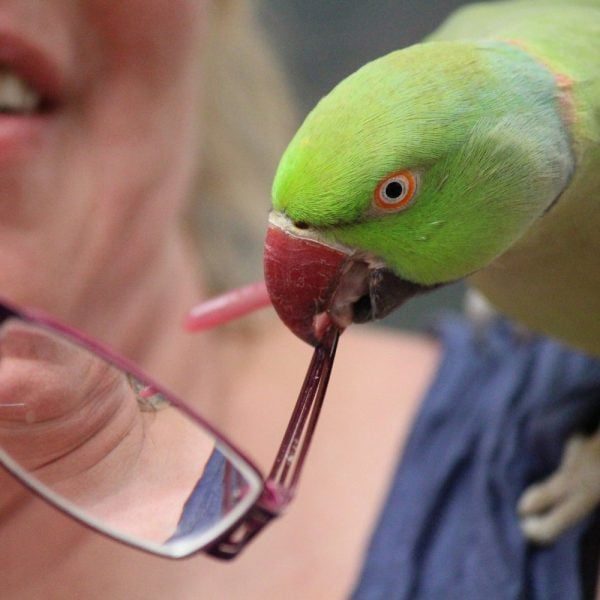
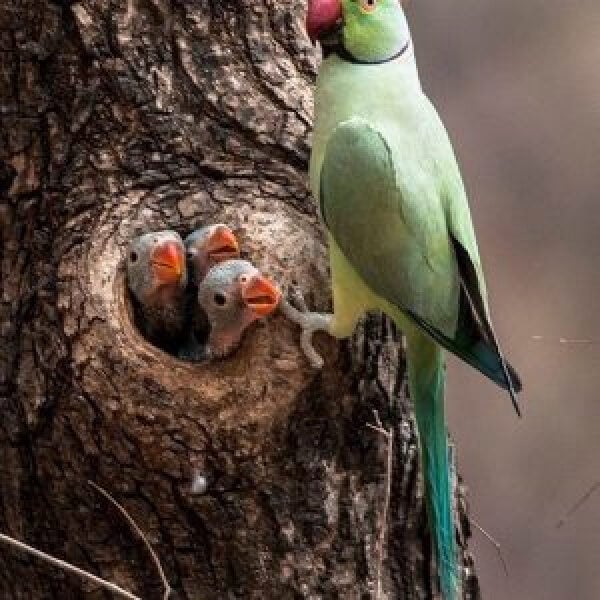
John Hollon, NY
11 Sep 2017Nature never ceases to amaze me, loved it since a kid and at 54 STILL impress and awe. Humbles yet inspires
WindyCityParrot
11 Sep 2017glad you enjoyed the post John
best
mitch
John Hollon, NY
11 Sep 2017Nature never ceases to amaze me, loved it since a kid and at 54 STILL impress and awe. Humbles yet inspires
WindyCityParrot
11 Sep 2017glad you enjoyed the post John
best
mitch
Lisa
12 Sep 2017Inspires awe, and also a phrase like “only a mother could love that face”!
WindyCityParrot
12 Sep 2017hahahaha
Lisa
12 Sep 2017Inspires awe, and also a phrase like “only a mother could love that face”!